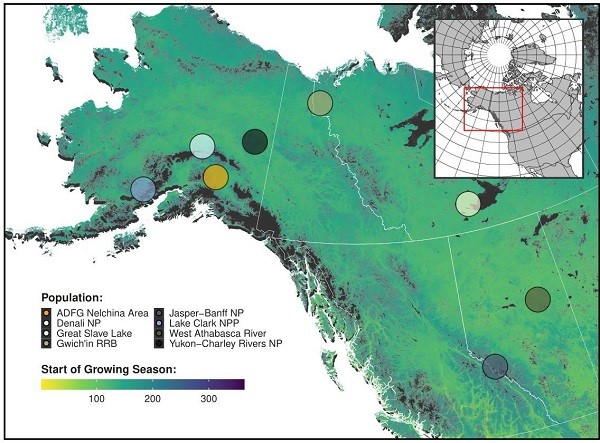The ORNL DAAC recently released the following Arctic-Boreal Vulnerability Experiment (ABoVE) dataset by Mahoney, P.K. et al. (2021):
ABoVE: Wolf Denning Phenology and Reproductive Success, Alaska and Canada, 2000-2017
This dataset provides annual gray wolf (Canis lupus) denning spatial information and timing, associated climatic and phenologic metrics, and reproductive success in wolf populations across areas of western Canada and Alaska over an eighteen year time period. In the study, wolves were captured from eight populations and released with Global Positioning System (GPS) collars. Data from 388 wolves were used to estimate den initiation dates and reproductive success in the eight populations. Each population was monitored from 1 to 12 years between 2000 and 2017.
To evaluate the effect of climate factors on reproductive phenology, aggregated seasonal climate metrics for temperature, precipitation, and snow water equivalent based on three biological seasons for seasonal wolf home ranges were produced. Normalized Difference Vegetation Index (NDVI) time-series data were used to estimate phenological metrics such as the start of the growing season (SOS), length of the growing season (LOS), and time-integrated NDVI (tiNDVI), and were summarized for the populations' home range.
The ABoVE is a NASA Terrestrial Ecology Program field campaign being conducted in Alaska and western Canada, for 8 to 10 years, starting in 2015. Research for ABoVE links field-based, process-level studies with geospatial data products derived from airborne and satellite sensors, providing a foundation for improving the analysis, and modeling capabilities needed to understand and predict ecosystem responses to, and societal implications of, climate change in the Arctic and Boreal regions.
Additional data from ABoVE and other relevant links can be found on the ORNL DAAC's ABoVE Project Page.
Citations: Mahoney, P., K. Joly, B. Borg, M. Sorum, T. Rinaldi, D. Saalfeld, H. Golden, D. Latham, A. Kelly, B. Mangipane, C. Lambert, L. Neufeld, M. Hebblewhite, N. Boleman, and L.R. Prugh. 2021. ABoVE: Wolf Denning Phenology and Reproductive Success, Alaska and Canada, 2000-2017. ORNL DAAC, Oak Ridge, Tennessee, USA. https://doi.org/10.3334/ORNLDAAC/1846

